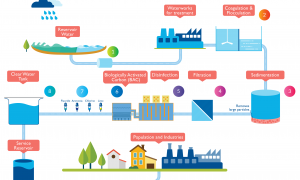🕑 Reading time: 1 minute
Canal Linings are provided in canals to resist the flow of water through its bed and sides. These can be constructed using different materials such as compacted earth, cement, concrete, plastics, boulders, bricks etc. The main advantage of canal lining is to protect the water from seepage loss.Contents:
What is Canal Lining?
Canal Lining is an impermeable layer provided for the bed and sides of canal to improve the life and discharge capacity of canal. 60 to 80% of water lost through seepage in an unlined canal can be saved by construction canal lining.
Fig 1: Canal Lining
Types of Canal Linings
Canal linings are classified into two major types based on the nature of surface and they are:- Earthen type lining
- Hard surface lining
1. Earthen Type lining
Earthen Type lings are again classified into two types and they are as follows:- Compacted Earth Lining
- Soil Cement Lining

Fig 2: Compacted Earth Lining
- Dry-mix method
- Plastic mix method

Fig 3: Soil Cement Lining
2. Hard Surface Canal Linings
It is sub divided into 4 types and they are- Cement Concrete Lining
- Brick Lining
- Plastic Lining
- Boulder Lining
- Cast in situ lining
- Shortcrete lining
- Precast concrete lining
- Cement mortar lining

Fig 4: Cement Concrete Lining

Fig 5: Construction of Brick Canal Lining
- Low density poly ethylene
- High molecular high density polythene
- Polyvinyl chloride

Fig 6: Plastic Canal Lining

Fig 7: Canal Lined with Boulders
Advantages of Canal Lining
- Seepage Reduction
- Prevention of Water Logging
- Increase in Commanded Area
- Increase in Channel Capacity
- Less Maintenance
- Safety Against Floods


